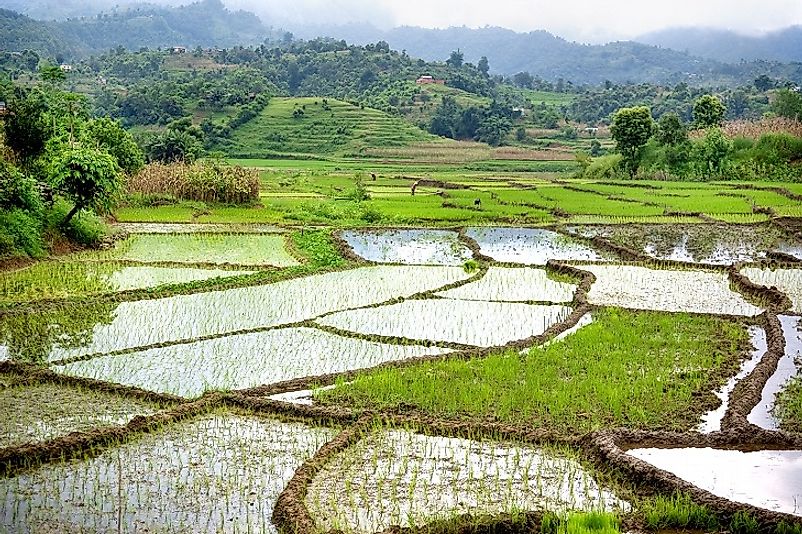Highest Usage Of Freshwater By Country

Some of the world’s most populous countries and largest economies also use the largest quantities of water, as doing so is necessary to meet the municipal, commercial, industrial, and agricultural needs of their people and economies. Water consumption has been on the increase in the recent decades, and an increase in global population is a major contributor to this increasing water consumption. Demand for the resource is estimated to increase by 64 Billion cubic meters annually. The countries which use the highest volumes of freshwater are briefly discussed and analyzed below.
India
India uses 7610.0 billion cubic meters of water annually. India gets its surface water from rivers such as the Ganges, Krishna, Brahmaputra, Indus, Godavari, and Mahanadi. The primary source of water in India is from underground aquifers which are replenished by rainfall and rivers. However, withdrawal from these underground sources has been increasingly made at a higher rate than subsequent replenishment raising concerns over depletion. The Ganges Basin is an example of an aquifer in India facing a rapid reduction. Due to inaccessibility of water in the rural areas, people resort to digging wells which contribute to further depletion of underground aquifers.
The agricultural sector in India is the largest consumer of water, accounting for nearly 90% of its consumption. The industry and the domestic sectors each consume a small percentage. India has one of the largest populations in the world who consume water in massive volumes for drinking and other domestic purposes. India is also an agricultural hub with products such as grain that require an ample supply of water. The country, in the recent years, has ramped up efforts to improve the quality of water going through the municipal drinking system. The planned systems for dispensation are, however, stretched to their limits by overpopulation in India’s largest cities. India’s population is subjected to waterborne diseases due to industrial and human pollution.
China
China uses 554.1 billion cubic meters of water annually. Agriculture, power, textiles and mining are top sectors in the consumption of China’s water resources. The southern part of China has the bulk of these water resources at nearly 80%, majorly made up of surface water from rivers and underground sources. There have been increasing concerns regarding the quality of surface water in China which is seen to be subject to industrial and human pollution especially in rural areas. China has undertaken significant strides to improve water quality in accessibility in urban areas, but similar developments in the countryside lag behind. China’s economy is growing at a high rate although there are concerns if the development is sustainable in regards to water resources. The principal aquifer at risk of depletion in China is the North China Plain Aquifer.
United States
The US uses 478.4 billion cubic meters of water annually. Most of the water in the US is surface water from lakes and rivers while the rest is groundwater. The agriculture, power, and textile industries use a substantial volume of this water. Due to its size, the US has numerous aquifers such as the Edwards Aquifer, the Ogallala Aquifer, and the Mahomet Aquifer. Some of these water resources are increasingly threatened by depletion. The Ogallala Aquifer has been subjected to large volumes of agricultural and municipal withdrawals while it is inadequately replenished. The water sector in the US produces high-quality water regarding citizens’ health and the environment. However, the water system is not exactly error free due to cases of industrial pollution. Notable lawsuits have been filed by the residents of Chicago and Flint, Michigan, over what they termed as contaminated tap water that endangered their health.
Pakistan
Pakistan uses 183.5 Billion cubic meters annually. Groundwater is the primary source of Pakistan’s water followed by surface water. Most of the water is utilized in the agricultural sector through irrigation as Pakistan is a major agriculture economy. Other areas that use the resource are industrial, domestic, and power generation. The Pakistan government has undertaken significant strides to improve water accessibility and safety. The steps taken are however not adequately funded, and safe water in Pakistan is major problem. Unsafe water leaves Pakistan’s population vulnerable to water- borne diseases. Waste water treatment in Pakistan is largely inadequate, and this leads to the contamination of water sources. Increasing aggressive irrigation in Pakistan has exposed some aquifers to depletion such as the Kuchlagh Basin. Changing climatic conditions have caused reduced rainfall such that aquifers are not adequately replenished. Depletion of groundwater is a looming crisis in Pakistan.
Concerns Over Depletion
Other high water consuming countries are Indonesia, which uses 113.3 billion cubic meters of freshwater per year, followed by Iran (93.3 billion), Vietnam (82.0 billion), Philippines (81.6 billion), Japan (81.5 billion), and Mexico (80.3 billion). Notably, emerging economies have a high water consumption rate. These countries use water to drive their economies especially in the industrial sector and power generation. Environmentalists are increasingly concerned if economic development in some of these countries is sustainable owing to the continued depletion of natural water sources.
Highest Use Of Freshwater By Country
| Rank | Ten Part Template | Annual Freshwater Withdrawals |
|---|---|---|
| 1 | India | 761.0 billion cubic meters |
| 2 | China | 554.1 billion cubic meters |
| 3 | United States | 478.4 billion cubic meters |
| 4 | Pakistan | 183.5 billion cubic meters |
| 5 | Indonesia | 113.3 billion cubic meters |
| 6 | Iran | 93.3 billion cubic meters |
| 7 | Vietnam | 82.0 billion cubic meters |
| 8 | Philippines | 81.6 billion cubic meters |
| 9 | Japan | 81.5 billion cubic meters |
| 10 | Mexico | 80.3 billion cubic meters |











